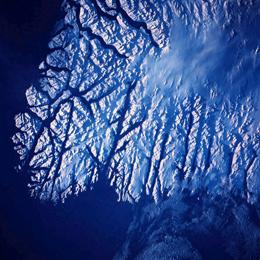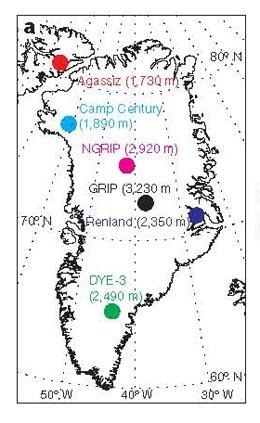Climate change warning from Greenland
Small rise in temperature thousands of years ago caused rapid melting of the Greenland ice sheet.
by Kerri Smith, Nature News, September 16, 2009
 The Greenland ice sheet could melt more rapidly than had been thought as a result of climate change. Getty
The Greenland ice sheet could melt more rapidly than had been thought as a result of climate change. GettyThe Greenland ice sheet melted much more rapidly as a result of warmer temperatures in the recent past than previously estimated, a team of international scientists has revealed. They warn that future warming could have more dramatic effects on the ice than researchers have assumed.
Between 9,000 and 6,000 years ago, Earth went through an unusually warm period. But puzzlingly, unlike data from many other spots in the Northern Hemisphere, measurements of isotopes in ice cores drilled from the Greenland ice sheet (GIS) have not reflected that temperature change. So models of the ice sheet's behaviour based on these data have suggested that the height of the ice above bedrock has remained quite stable during the past 12,000 years.
Now, new data from ice cores drilled in six different places on and around the ice sheet reveal that this unusually warm period affected the GIS too, and that in response to these temperatures — which were 2–3 °C hotter than the current temperature — it lost 150 metres in height at its centre and shrank by 200 kilometres at the edges.
Big thaw
A team led by Bo Vinther from the Niels Bohr Institute at the University of Copenhagen, Denmark, analysed the ice cores for evidence of the regional temperature and elevation of the Greenland ice sheet in the Holocene, the geological era that began about 12,000 years ago. Each core is basically a long rod of ice, drilled down 3 kilometres to the bedrock. It is sliced up and the content of particular isotopes, such as those of oxygen, in water and air bubbles from the appropriate section is measured in the lab.
 The researchers analyzed data from ice cores in six different places around Greenland. B. M. Vinther, et al.
The researchers analyzed data from ice cores in six different places around Greenland. B. M. Vinther, et al. To work out the ambient temperature on the ice sheet, the team had to disentangle changes in temperature that were due to the change in elevation from changes in temperature due to climate change — a task that has proved difficult in the past. To do this, they analysed two ice cores from small ice caps that did not form part of the main sheet and which, the researchers believe, did not change elevation. They used these measurements to work out the temperatures on the ice caps, and by comparing these with temperatures obtained from main-sheet ice cores were able to work out the thickness of the main sheet at different times in the past.
"What we can now say for sure is that 8,000 years ago it was in fact 2-3 °C warmer than now, and it was this 2-3 degrees that actually caused quite a bit of melting," says Vinther. "And that of course gives us an indication that if climate was to warm a few degrees, then the ice sheet might start to lose mass again." The team's results are published in Nature1.
Forcing the issue
Eric Rignot, who studies ice and climate at the University of California, Irvine, and NASA's Jet Propulsion Laboratory in Pasadena, is excited by the new result but cautious about applying it to future warming. He is working with others to develop better models of ice-sheet behaviour for use in the next report of the Intergovernmental Panel on Climate Change, with the goal of explaining patterns observed in the past decade.
"Climate forcing is of a very different nature today to the Holocene," he says, but notes that analyzing the climate of the past "still gives us information on how sensitive the ice sheet is to climate change."
Rignot agrees with Vinther and his team that in future the ice is likely to melt more rapidly than current models predict. "How quickly is difficult to say," he says. But, he adds, we need to be using this data to think one step ahead. "The climate machine is moving on in the meantime."
Vinther, B. M. et al. Nature 461, 385-388 (2009). | Article
Link: http://www.nature.com/news/2009/090916/full/news.2009.917.html






No comments:
Post a Comment